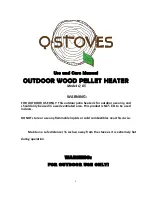
11
®
INSTALLATION INSTRUCTIONS
HEALTH AND SAFETY PRECAUTIONS
Please take care when installing the stove that the requirements of
the Health and Safety at Work Act 1974 are met. Adequate facilities
must be available for loading, unloading and site handling.
Some types of fire cement are caustic and should not be allowed to
come into contact with the skin. In case of contact, wash with plenty
of water.
If there is a possibility of disturbing any asbestos in the course of
installation then please use appropriate protective equipment.
There must not be an extractor fan fitted in the same room as the
stove as this can cause the appliance to emit fumes into the room.
The combustion air supply ducting must be connected to a suitable,
permanently open air inlet. See ‘Air supply’ section for details. This
stove is capable of intermittent operation. This stove is not suitable
for use in a shared flue system.
In addition to these instructions the requirements of BS 8303 and
BSEN 15287-1:2007 must be fulfilled. Local Authority Bylaws and
Building Regulations, including those referring to national and
European Standards, regarding the installation of Solid Fuel burning
appliances, flues and chimneys must also be observed.
UNPACKING THE STOVE
The stove arrives bolted to its pallet and covered with a cardboard
box. The bands are first removed and then the box is lifted, then the
stove is released from the pallet by removing the 2 brackets using a
13mm spanner. The bracket on the rear is removed with a 10mm
Spanner.
The pallet is intended to be cut up and used for kindling fuel
AIR SUPPLY
The fire needs air for combustion, there are various ways of
supplying this, and they must meet the requirements of the building
regulations.
One way of meeting this requirement as outlined in Approved
Document J is to have a permanently open air vent into the room.
The C four Insert has a 5kW output and therefore a permanent air
vent is not normally required. If the air permeability is less than 5.0
m³/(h.m²) then the required minium vent area will be 27.5
cm²(4.3in²)
If using this method then the air supply ducting may be terminated in
the room, or the ducting connections on the stove can be removed
from the inside and outside of the convection casing and the rear of
the air box. The blanking plate should also be removed from
underneath the air box and fitted in the place of the ducting
connections on rear of the convection casing. This is so that air is
taken from between the fire box and the convection casing.
Alternatively a fixed ducted air supply method can be used as shown
in fig. 13. One end of the air supply ducting is connected to the stove
and the other is terminated outside. The ducting must be 100mm
dia, non-combustible, less than 5.5m long and must not have more
than five 90° bends and two 45° elbows. It must be sleeved where it
passes through the external wall. The inlet must be permanently
open and the duct free of any constrictions. The inlet must have a
suitable grill to prevent entry by vermin, and should be positioned so
that blockage by leaves or other debris will be avoided. Ensure that
rain or flood water will not enter the duct. A spillage test must be
carried out during commissioning to verify adequate air supply for
combustion - see the section on Commisioning.
External air kits are available, please contact Charnwood for more
information (Ref TIS 120)
CO ALARMS
Building regulations require that whenever a new or replacement
fixed solid fuel or wood/biomass appliance is installed in a dwelling a
carbon monoxide alarm must be fitted in the same room as the
appliance. Further guidance on the installation of the carbon
monoxide alarm is available in BS EN 50292:2002 and from the
alarm manufacturer's instructions. Provision of an alarm must not be
considered a substitute for either installing the appliance correctly or
ensuring regular servicing and maintenance of the appliance and
chimney system.
SPECIFICATIONS
Multifuel results obtained using ‘Homefire’ fuel burned over a 1hr period.
Wood Figures were achieved burning seasoned hardwood logs over a 45
minute refuelling period.
Wood
Multi Fuel
Output
5kw
4.9kw
Stove Weight
105kg
105kg
Flue Gas Temperature
279°C
282°C
Flue Gas Mass Flow
4.4g/s
4.3 g/s
Average refuelling cycle
0.75hrs
1.0 hr
Min Flue Draught
12Pa
12Pa
CO at 13% 02
0.08%
0.18%
Maximum Log Size
300mm long
x 75mm diameter








































